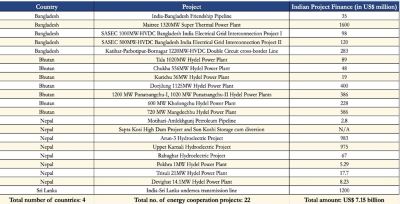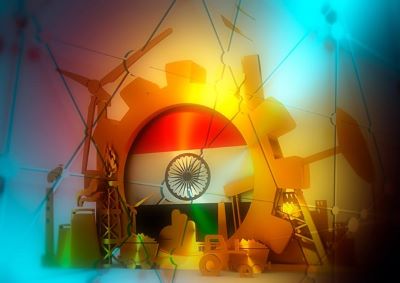Context-
India's energy security has become increasingly crucial in recent decades. As the country’s energy imports surged to 40% of total requirements in 2022, up from 18% in 2002, its energy strategy has had to adapt. The diversification of energy partners from 14 to 32 over the same period underscores India's efforts to secure and stabilize its energy supplies.The India’s regional energy diplomacy is focusing on infrastructure development in South Asia, the geopolitical motivations behind these initiatives, and their implications for regional connectivity and influence.
India’s Energy Cooperation in South Asia
Growth in Development Assistance
Since 2005, India’s development assistance to its South Asian neighbours has grown significantly, reflecting its increased economic capabilities post-1991 economic reforms. Development assistance rose at an average annual rate of 11.4%, reaching USD 7.6 billion in 2023 from USD 968 million in 2005. This increased investment enables India to forge stronger economic partnerships in the region.
Energy Investments and Projects
Between 2005 and 2023, India invested approximately USD 7.15 billion in energy infrastructure across South Asia. Key projects include cross-border transmission lines, hydel power plants, oil and gas pipelines, and undersea grid integration lines. These initiatives are crucial for enhancing energy connectivity and trade among India, Bhutan, Bangladesh, and Nepal. For instance, electricity trade among these countries grew from 2 billion units in 2016 to 8 billion units in 2023.
Source: The Ministry of Power, GoI, the Ministry of External Affairs, GoI and the EXIM Bank of India
Specific Country Initiatives
● Nepal: India’s energy cooperation with Nepal has culminated in a 25-year power purchase agreement, with India committed to buying 10,000 MW of hydel energy annually by 2030. Nepal’s surplus hydel power, bolstered by its extensive development of hydel plants, meets the energy needs of India’s border regions and northern states, which are often energy deficient.
● Bhutan: India imports 1500 MW of electricity from Bhutan, comprising 70% of Bhutan’s hydel power capacity. Bhutan is also collaborating with multilateral development banks and India to increase its hydel power capacity to serve neighboring energy-deficient countries like India, Bangladesh, and Myanmar.
● Bangladesh: India’s collaboration with Bangladesh involves importing energy via the India-Bangladesh Friendship Pipeline (IBFP) and a newly developed electricity transmission network. India is working to enhance energy connectivity by linking Bhutan and Nepal with Bangladesh through Indian territory.
Regional Connectivity Vision
India envisions a South Asian energy connectivity that integrates these nations through physical infrastructure and policy coordination. This includes the development of a Bangladesh-Bhutan-India-Nepal (BBIN) economic corridor, which aims for greater regional integration and synergy among countries with varying energy needs and surpluses.
Countering Beijing’s Belt and Road Initiative (BRI)
Chinese Influence and the BRI
China’s Belt and Road Initiative (BRI), launched in 2013, has significantly impacted South Asia, with over USD 150 billion invested in infrastructure projects by 2023. Among these, USD 54 billion was directed towards energy infrastructure in countries like Bangladesh, Nepal, Myanmar, Sri Lanka, and Pakistan. The BRI’s energy investments align with China’s energy security strategy and contribute to its growing geopolitical influence in the region.
India’s Strategic Response
In response to China’s BRI, India has intensified its development aid and energy cooperation efforts in South Asia. India’s strategy includes competing with China for offshore energy assets in Sri Lanka and Bangladesh, investing in renewable energy projects in Nepal, and strengthening ties with Maldives, which recently saw a pro-China administration come to power. India’s goal is to enhance regional connectivity and economic integration as a countermeasure to Chinese influence.
Geopolitical and Strategic Implications
Regional Integration and Economic Growth
India’s energy diplomacy is designed to promote economic growth through regional integration. By developing energy infrastructure and fostering interdependence with its South Asian neighbours, India aims to bolster its economic security and regional influence. The increased energy trade and collaborative projects not only enhance energy security but also create economic synergies among the countries involved.
Challenges and Future Prospects
Despite the mutual benefits, India’s energy diplomacy faces challenges, including geopolitical tensions and competing interests. The ongoing rivalry with China and regional disputes may impact the success of these initiatives. However, India’s strategic investments and collaborative projects are likely to play a pivotal role in shaping the region’s future, contributing to economic stability and regional integration.
Opportunities in Key Regions
● Guyana: Guyana has emerged as a major success story in recent years, particularly for oil. Exxon has made substantial investments there, highlighting its potential. The Indian diaspora could play a crucial role in strengthening ties between India and Guyana, leveraging cultural and economic connections.
● Myanmar: Indian companies have invested in the Myanmar pipeline, which has proven profitable. However, the gas from this pipeline is currently redirected to China. There remains an opportunity for India to secure a more advantageous stake in Myanmar's energy resources.
● Iran: India holds a stake in the Farzad B offshore gas block in the Persian Gulf. However, current US sanctions against Iran present challenges. There is a pressing need for India to explore ways to navigate these sanctions and secure more upstream oil fields to meet its growing energy demands.
● Bhutan and Nepal: Both Bhutan and Nepal have substantial hydro-power potential. Bhutan is already harnessing and exporting its hydro-power, but Nepal has not fully benefited from exporting its hydro-power to India. Indian diplomacy must focus on harmonizing the interests of both countries to optimize the use of their hydro-power resources.
Conclusion
India’s energy cooperation with its South Asian neighbours is a critical component of its foreign policy and energy security strategy. Through significant investments in regional energy infrastructure and fostering interdependence, India seeks to support its economic growth, counterbalance Chinese influence, and enhance its global standing. As India continues to rise on the world stage, its energy diplomacy will be increasingly vital in shaping the future of the South Asian region and beyond.
|
Probable Questions for UPSC Mains Exam- 1. Discuss the significance of India’s regional energy diplomacy in South Asia. How does it align with India's broader foreign policy objectives and what challenges does it face in the context of countering Chinese influence through the Belt and Road Initiative (BRI)? (10 Marks,150 Words) 2. Analyze the impact of India’s energy investments in its South Asian neighbors, such as Nepal, Bhutan, and Bangladesh, on regional connectivity and economic integration. How do these investments contribute to India’s energy security and geopolitical strategy? (15 Marks,250 Words) |
Source- The Indian Express/VIF/ORF







